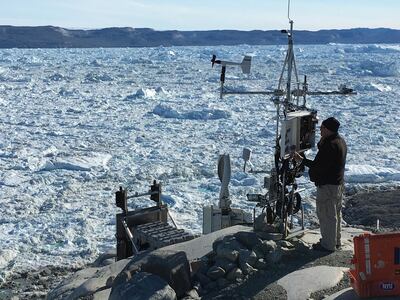It has been described as watching a city break apart. A thundering sound, cracking and shaking as ice sheets the size of skyscrapers and city blocks break off glaciers and tumble into the sea.
This process, known as calving and exacerbated by global warming, has been studied by researchers at New York University Abu Dhabi for years.
Calving is a normal event and glaciers are meant to recover much of their icy mass over the winter. The global indiscriminate use of fossil fuels, however, has accelerated its frequency, eroding ancient glaciers in Greenland, Iceland and Alaska because they are unable to replace what is being lost fast enough.
But scientists in Abu Dhabi may have found a potential solution to slow the process and the rise of global sea levels.
A belt made up of a thick mixture of crushed ice and icebergs, packed tightly against the glaciers – like a doorstop – has been found to slow the calving process and hold glaciers together.
The scientists ventured to Greenland in the summer of 2016 to install a new radar system to better understand the process at the country's fastest-thinning ice mass, the Jakobshavn Glacier.
Their findings, published in the British journal Nature Communications, showed that the ice mixture, known as a melange (named after the French word for mixture), pressed up against the glacier stopped calving in spring and early summer.
But as the melange thins later in summer, calving begins, part of a process that is causing the glacier to give up more ice than it accumulates.
Professor David Holland, principal investigator for NYUAD’s Centre for Global Sea Level Change, said the researchers would monitor the melange over the next decade.
“This will help us to better observe and understand the role of the melange in acting as a sort of door holding back the Greenland ice sheet and its contribution to global sea level rise,” he said.
Scientists have long known that melange can impede glaciers as they move towards the sea, but they have not had the data to fully understand the phenomenon.
“Iceberg calving has been challenging to model,” said Timothy Dixon, a professor at the University of Southern Florida and one of the researchers involved.
“One of the big unknowns in future sea-level rise is how fast Greenland falls apart, and iceberg calving is one of the least understood mechanisms.”
Climate change-induced reductions in glacier size are contributing to global sea level rises, which are running at more than 3mm per year.
In March, a Nasa study found that the Jakobshavn glacier was increasing in size, after retreating at a rate of 40 metres a year in 2012.
Though this was good news, scientists said it was likely temporary blip and showed how large a role ocean temperatures played in glacier retreats.
Last year, the NYUAD – USF research team captured a calving event in which a vast, 6.4-kilometre long iceberg broke free from the Helheim Glacier in eastern Greenland.
The size of the glacier is comparable to the length of Abu Dhabi’s Corniche from the Founder's Memorial to the Sheraton.
Also involved in the study were two former NYUAD researchers, Dr Irena Vankova and Dr Denis Voytenko, and Surui Xie, a PhD student at USF.



